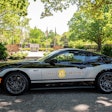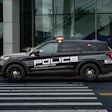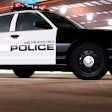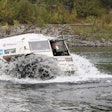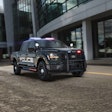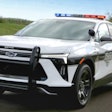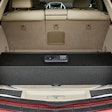I've seen a lot of different cop cars over the years. When I was a kid, big V-8 black-and-white sedans would prowl the highways of my native North Carolina, hunting down speeders. Back in the early '80s when I worked on small-town newspapers, some of the agencies that I covered drove "K" cars. They were trying to save gas, and the government was trying to keep Chrysler in business. Then in the '90s when I lived in Japan for a few years, I realized that Toyota could make patrol cars. Yes, I've seen a lot of police cars over the years, but I don't think I've ever seen a better-looking crop of patrol cars than the class of 2006.
Each one of these cars has great lines. They look both modern and a bit retro. And they have plenty of engine to get the job done.
They also offer agencies a wide variety of body shapes and sizes to accommodate various law enforcement needs. There are now pursuit-rated sedans, muscle cars, station wagons, and SUVs. The following is a quick look at the patrol vehicles that you may be driving in the near future. It includes our impressions of some of the cars that we have driven and testing data from the Michigan State Police.
Chevrolet Impala 9C1
The Chevy Impala 9C1 remains the only American-built front-wheel-drive car commonly used in police duty. For 2006, the Impala's sheet metal is basically the same as it was for 2005, but Chevy has added some new design touches to both the interior and the exterior of this proven police car. More importantly, Chevy's engineers have spent some time working on the drive train.
Police-tuned Impalas have always had a little more giddyup than the civilian model, and some of the engineering tweaks on the 2006 version make the car even faster and more agile. Chevy has dropped a new transmission into this baby that makes its 3.8-liter, 240-hp power plant more efficient. In addition, the car now comes with speed-rated Pirelli tires. Last summer, Chevy said the combination would result in a top speed of about 140 mph, a sizable jump over the 2005 model's tested 123 mph. And the company wasn't blowing smoke; the Michigan State Police Test team recently drove a 2006 Impala to 142 mph.
In addition to nearly 20 more miles per hour, the new Impala has a couple of great new features, including the same plug-and-play electrical architecture as the Tahoe pursuit vehicle. This makes it a lot easier for fleet managers and their crews to hook up computers, lights, radar, video, and all the other gadgets that are needed in 21st-century police work. Of course, all that stuff is a drain on the battery, but Chevy has an answer for that too. The alternator has a sensor that revs it higher when the equipment on the car is drawing too much juice.
The 2006 Impala looks a lot like the 2005 on first glance. However, there have been some changes. The 2006 is a little more aerodynamic and the engineers have added some trunk space on essentially the same wheelbase as the 2005 model.
Gas mileage also remains a selling point for the Impala. Despite the car's blistering performance, it's still economical at an EPA combined rate of 21 miles to the gallon.
Chevrolet Tahoe PPV
Police pursuit vehicles are getting bigger. That makes sense. With the popularity of SUVs over the last decade, many of the vehicles that you pull over are now bigger than your car. The other reason that a cop would want a big car these days is so that he or she will have room for all the gear and equipment. It seems that every new week brings with it something new that you have to put in your rolling office.
The Tahoe is an excellent solution to the office space question, especially for patrol supervisors. It's big, sitting on a wheelbase of 116 inches and weighing more than two-and-a-half tons. Yet, it's also fast and well deserving of its pursuit vehicle classification.
The Tahoe's 5.3-liter engine generates 285 horsepower at 5,200 rpm and can push the more than 5,000-pound vehicle to 124 mph. Let's put it this way, any miscreant who thinks he can outrun the cops just because they're in this SUV had better have something under his hood because the Tahoe can flat haul butt.
There's more to the pursuit-rated Tahoe than just speed and size. Its front and rear suspension have been upgraded for excellent performance, and its hydro-boost power, anti-lock braking system means you will stop when you need to. The Michigan State Police Test found that the Tahoe can go from 60 to zero in 148 feet. That's only seven more feet than the Impala, which weighs more than a thousand pounds less than the Tahoe.
Of course, the Tahoe is an SUV, so it costs more than a standard patrol car to purchase and to operate. And don't look for gas economy. The Tahoe pursuit package has an EPA combined score of 16 miles per gallon. There is an E85 Ethanol version of the Tahoe, but it only gets a combined EPA mileage of 12.
Dodge Charger
There was a time when Dodge was synonymous with words like "fast" and "powerful." It was a time when new muscle cars rolled off Dodge's assembly line faster than SUVs and econoboxes do today. And of all the vaunted Dodge super cars, no name was more powerful than Charger. The late '60's and early '70's Chargers were perhaps the largest two-door coupes ever produced. Oh, yeah, and they had deep-throated Hemi engines that could carry all that bulk at high speed.
Today's Charger is a much tamer version of its granddaddy, and you won't ever see Bo and Luke Duke climbing into its cockpit through the windows. Instead, Bo and Luke, like everybody else, will have to enter the Charger through one of its four doors. And if you want to hear muscle car enthusiasts howl, mention the four-door Charger, which some say resembles a Volvo or Mercedes more than it does the Charger coupe of legend.
From Dodge's standpoint, however, having four doors on the 2006 Charger has its advantages. One distinct advantage is that DaimlerChrysler can market the new Charger as a pursuit-rated vehicle suitable for police patrol.
The police Charger comes in two versions: a 3.5-liter model and a much more powerful 5.7-liter model. Most agencies that adopt the Charger will likely go for the 3.5-liter model, fearing the liability that comes with the bigger engine. But don't think of the 3.5-liter Charger as wimpy. It's not. This standard Charger engine generates 250 horsepower at 6,400 rpm, and the Michigan State Police got it up to 135 mph. In a straight acceleration test, the standard Charger reached 110 mph in .65 miles.
Oh, who am I kidding? What you really want to know about is the beast. OK. Here goes: The 5.7-liter power plant in the Charger produces 340 horsepower at 5,000 rpm. And, oh, yes, it's a Hemi.
This puppy might as well be rocket powered. The Michigan State Police tested it to 150 mph and, at 110 mph in .39 miles, it accelerates fast enough to pin your ears back.
Braking is comparable for both versions of the Charger pursuit vehicle. The 3.5-liter Charger goes from 60 to zero in a hair over 130 feet. The 5.7-liter Charger is about 200 pounds heavier and goes from 60 to zero in a little more than 133 feet.
EPA-reported gas mileage on both Chargers is pretty good. The 3.5-liter Charger gets a combined rating of 22 miles per gallon. The 5.7-liter hemi Charger is estimated to get 20 miles to the gallon.
Dodge Magnum
Station wagons were the mini-vans of the '60s. And back then, the soccer moms of that era who were called "den mothers" for the Cub Scouts and troop leaders for the Brownie Scouts, drove these things and they were always full of rug rats. So I was a little startled when I first saw the Dodge Magnum station wagon being marketed as a cop car. A patrol car in a station wagon configuration is just weird to me. Yes, I know they used to be common, but station wagons themselves are rare today, and they are even rarer in police service.
All that said, Dodge's cop wagon is a big success. In fact, the Dodge Magnum is such a popular special service vehicle for K-9, SWAT, and other officers who need a big payload capacity that Dodge has produced two pursuit-rated versions for 2006.
Like the patrol car version of the Charger, the police Magnum comes with either a 3.5-liter standard engine or a 5.7-liter Hemi. The Magnum has a 120-inch wheelbase and weighs slightly more than two tons. Yet, even the standard version can hit top speeds in the 130s. The Hemi's top speed isn't much higher, but its acceleration is a remarkable 110 mph in .40 miles. That makes the standard 3.5-liter Magnum look absolutely sluggish at 110 mph in .70 miles. However, it should be noted that the standard 3.5-liter Magnum is quicker from a standard start than the Tahoe and comparable to the Impala or Crown Vic.
Braking performance is also one of the Magnum's strong points. Despite the fact that the car weighs a little more than 4,000 pounds, the 3.5-liter model can go from 60 to zero in a smidgen over 128 feet. The Michigan State Police report that the slightly heavier hemi Magnum can make the same stop in 131 feet.
Ford Crown Victoria Police Interceptor
Police agencies nationwide should be thankful for all those civilians who buy Crown Vics. Their vehicle of choice acts as a force multiplier because just about any motorist seeing the Crown Vic's distinctive grill in his or her rearview mirror is going to think "cop," whether the car has light bars or not. And the reason is simple, the Crown Vic is the most common vehicle in American police service.
Why is the Crown Vic so popular with police agencies? A lot of reasons. First, it's a prime example of a large, rear-wheel-drive American sedan. It's the kind of car-four doors, big engine, lots of space-that used to be thought of as a "family car." This is the kind of car that people once used to drive the family to Thanksgiving dinner. In other words, it has a lot of room for officers, equipment, and prisoners.
The Crown Vic also offers a balance of size and power that has proven to be very effective in law enforcement applications. The Crown Vic has a 144-inch wheelbase-almost as big as the Chevy Tahoe-and a 4.6-liter engine that generates 250 horsepower at 5,000 rpm.
The 2006 Crown Victoria Police Interceptor comes in two versions: one has an axle ratio or 3.55 to one; the other has an axle ratio of 3.27 to one. The Michigan State Police Tests show that the top speed for the 3.27 model is about 130 mph, 10 miles per hour faster than the 3.55 model. However, the 3.55 model is a little faster off the line, reaching 110 mph in .65 miles vs. the 3.27's .65 miles. In the braking tests, the 3.55 also stopped a hair faster than the 3.27.
As far as gas mileage, both models of the Crown Vic Police Interceptor have an EPA combined score of 18 miles per gallon. That's 23 on the highway and about 16 in the city.










